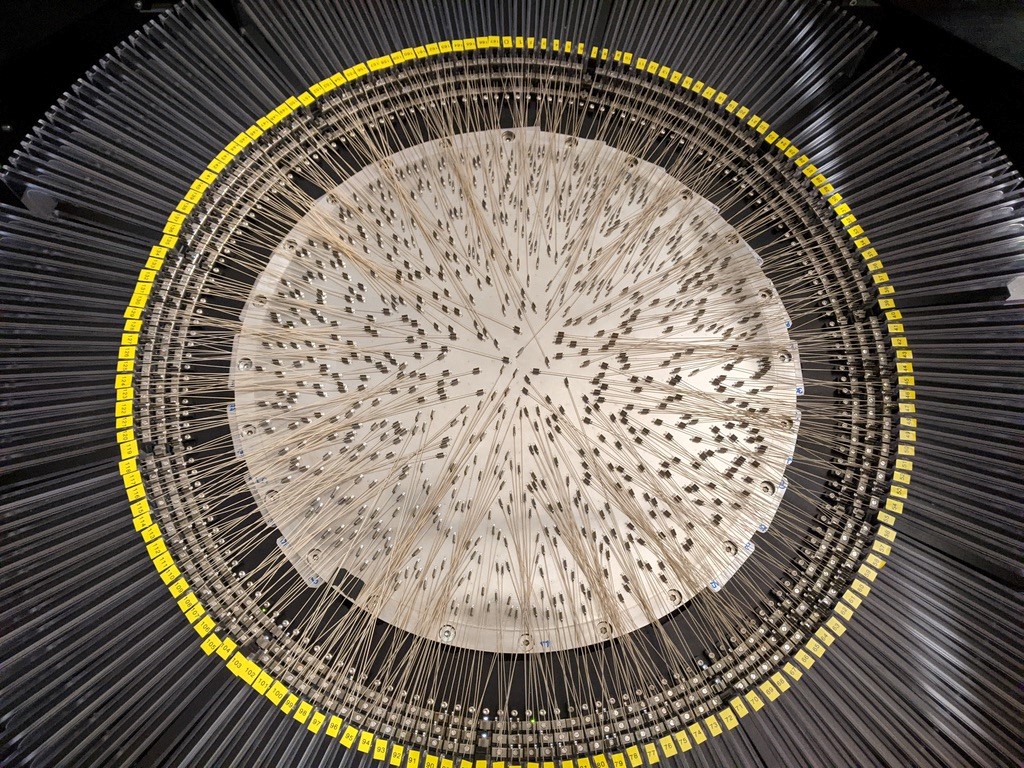Stof remt schokgolf bij iconische groep sterrenstelsels
De schokgolf die door een van de vijf sterrenstelsels van het Kwintet van Stephan teweeggebracht wordt, is minder ontwrichtend dan verwacht. Waarschijnlijk wordt de schok gedempt door stofdeeltjes in het omringende gas. Dat blijkt uit de analyse van de eerste wetenschappelijke waarnemingen van WEAVE, een mede in Nederland ontwikkeld instrument voor een telescoop op het Spaanse eiland La Palma.
Een groep van meer dan vijftig astronomen, onder leiding van Marina Arnaudova (Universiteit van Hertfordshire, Verenigd Koninkrijk) presenteert deze eerste wetenschappelijke resultaten vrijdag in het vakblad Monthly Notices of the Royal Astronomical Society.

3 miljoen kilometer per uur
De onderzoekers keken naar het bewegen van gas in het Kwintet van Stephan. Dat is een groep van vijf sterrenstelsels op 300 miljoen lichtjaar afstand die in 1877 is ontdekt door Édouard Stephan. Een van de vijf sterrenstelsels, NGC 7318b, snelt door het gebied met 3,2 miljoen kilometer per uur. Dat veroorzaakt een schokgolf die op zijn beurt voor chaotische bewegingen van gaswolken zorgt.
Twee gezichten
De onderzoekers ontdekten dat de schokgolf twee gezichten heeft. Als de schok door koud gas beweegt, verplaatst hij zich met hoge snelheid, worden elektronen van atomen losgerukt en blijft er een gloeiend spoor van geladen gas achter. Als de schok echter door heet gas gaat, zwakt hij af. De onderzoekers vermoeden dat er in het hete gas stofdeeltjes aanwezig zijn die de schokgolf opvangen.
Eerste resultaten
“We hebben WEAVE 15 jaar geleden bedacht. Een uitstekend team van ingenieurs en wetenschappers heeft dit instrument gerealiseerd en de uitstekende resultaten van Martina laten zien hoe krachtig WEAVE zal zijn”, zegt Scott Trager (Kapteyn instituut, Rijksuniversiteit Groningen), wetenschappelijke projectleider van WEAVE.
Weefgetouw
WEAVE staat voor William Herschel Telescope Enhanced Area Velocity Explorer. Met het instrument kunnen astronomen onder andere snelheden van duizend sterren en sterrenstelsels tegelijk meten. De kern van WEAVE bestaat uit bijna tweeduizend verplaatsbare glasvezels die wel wat weghebben van een weefgetouw.
WEAVE is ontwikkeld en gebouwd door Nederland, Spanje en het Verenigd Koninkrijk met hulp van Frankrijk en Italië. In de zomer van 2021 was het instrument bijna klaar voor gebruik. Eind 2022 werden de eerste waarnemingen verricht. Nu, eind 2024, zijn daarvan de resultaten geanalyseerd en gepubliceerd.
Tekst gaat verder onder afbeelding.

Large Integral Field Unit
De zogeheten first light-waarnemingen werden gedaan met de Large Integral Field Unit. Dit systeem is ontwikkeld en gebouwd door de Optische/Infraroodgroep van de Nederlandse Onderzoekschool voor Astronomie.
Tekst gaat verder onder afbeelding.

Wetenschappelijke artikelen
WEAVE first light observations: Origin and dynamics of the shock front in Stephan's Quintet. Door: M.I. Arnaudova et al. In: Monthly Notices of the Royal Astronomical Society, 22 november 2024. [origineel (open access) | preprint (pdf)]
The wide-field, multiplexed, spectroscopic facility WEAVE: Survey design, overview, and simulated implementation. Door: S. Jin et al. In: Monthly Notices of the Royal Astronomical Society, Volume 530, Issue 3, May 2024 [origineel (open access)]
Meer nieuws
-
06 januari 2026
AI-phasie: kunstmatige intelligentie helpt bij taalgebrek
